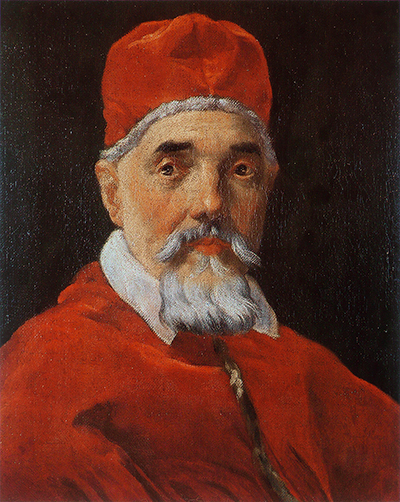Portrait of Pope Urban VIII, created in 1632 AD by Gian Lorenzo Bernini, is an oil-on-canvas painting that was commissioned by its subject and namesake.
Bernini, heralded as a seventeenth-century Michelangelo, was famous in Rome for his supreme abilities as an architect and sculptor while his skill with the paintbrush was also much admired in the city. Urban VIII, born Maffeo Barberini, was a generous patron of the arts and hired the Neapolitan artist to paint a memorable portrait that would capture the Supreme Pontiff at the height of his powers. The painting, showing Urban VIII in a similar pose to later busts of him that Bernini created, could be regarded as a precursor to those later works that were sculpted out of stone.
Urban VIII, sporting a medium-length grey beard and moustache, is wearing the traditional camauro hat and a red coat with a white collar while his dark eyes are opened wide and his eyebrows are raised. The camauro, fashioned from red velvet and trimmed with ermine fur, evolved from an academic headdress that was worn by cardinals in the Middle Ages and was incorporated into the papal attire during the fifteenth-century. The Pope, visible from the chest up and superimposed upon a black background, sets his quizzical gaze upon the viewer. A shadow, falling on the left-hand side of the Pope's face, indicates that the source of light is located to the right of the subject. The Supreme Pontiff, whose lips are almost as red as his coat and hat, meets the viewer's eyes with an expression of mild surprise.
It is believed that Bernini, distracted by other projects in the city of Rome, never finished the painting during his lifetime. Bernini, who died in 1680 AD, was still a young man at the time of the portrait's composition and would go on to serve other popes after the death of Urban VIII in 1644 AD. The painting's subject, under whose patronage the Italian artist would become Rome's chief architect, may have believed that Bernini's immense talents were better suited to grander projects than a humble oil-on-canvas painting. Stone, to Urban VIII's mind, may have been a better material to preserve his image for posterity than oil and pigment. The portrait, situated in Rome, measures sixty-seven centimetres by fifty centimetres and resides in the Galleria Nazionale d'Arte Antica Galleria Nazionale d'Arte Antica.
Geocentrism, the belief that the earth is the centre of the universe, was under attack at the time in which Berini was painting Urban VIII's portrait and the reigning Pope maintained that the sun and all heavenly bodies revolved around the earth. The belief in heliocentrism, which states that the earth revolves around the sun, was considered to be heretical at the time of the portrait's creation and Galileo would be tried by the Inquisition in the following year. This portrait of Urban VIII, whose exquisite tastes in art and architecture contrasted with his inflexible dogmatism in the face of scientific progress, captured the face of a controversial and self-contradictory figure who retains the ability to inspire debate in the modern era.




